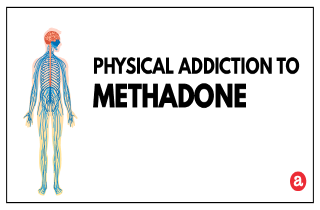Most often, methadone is primarily used in the detoxification and maintenance of individuals dependent on opiates (particularly heroin) and the treatment of people with severe and chronic pain. However, a person can develop an addiction to methadone if the opioid medication is abused.
How can you know if you are physically or psychologically addicted to methadone? What’s the difference between the two? We review the signs of methadone addiction and you options for help. Then, all of your questions about methadone are welcomed at the end. In fact, we try to respond to all legitimate questions personally and promptly.
Physical dependence on methadone
One characteristic of most psychoactive drugs – including methadone – is that the body adapts to the regular dosing. This condition where the body gets used to the presence of methadone is called “drug dependence”. Over time some users may require increasingly larger doses in order to experience the same effects as when they started using methadone. This is called “drug tolerance”.
While drug dependence and tolerance may be signs of addiction…when experienced with no other symptoms…they do not necessarily INDICATE addiction.
On the other hand, addiction to methadone can be defined as the condition of being habitually or compulsively occupied with, or involved in the use and abuse of methadone. There are two main components of the definition of methadone addiction:
- The first symptom of addction is that individuals who are addicted to methadone use this medication regularly and habitually despite the harms it causes.
- The second main symptom of addiction is the occurrence of compulsive methadone use which is generally beyond the individual’s conscious control.
In other words, methadone addiction refers to a behavioral syndrome where using the substance seems to dominate the individual’s motivation. On the other hand, methadone physical dependence occurs as an expected result of the body’s adaptation to methadone. When physically dependent on methadone, the user will experience withdrawal symptoms upon cessation or significant dose reduction.
Physical signs of addiction to methadone
It’s difficult to note physical signs of addiction to an opioid drug like methadone. Often, signs of addiction can mirror signs of drug dependence. So, you see how it can get hazy? However, some of the following physical signs and symptoms of methadone addiction may be present in methadone addicts:
- constipation
- constricted pupils
- increase in pain
- nausea
- slowed respiration
- sweating
- vomiting
Treating physical symptoms of methadone problems
If you have a problem with methadone…what are your first steps towards getting off methadone for good?
STEP 1: Get methadone out of your system. Methadone withdrawal refers to the physical and emotional effects experienced when you are physically dependent on this drug. However, the withdrawal process itself is different for every individual. The length and severity of the withdrawal symptoms vary depending on the gravity of your methadone addiction problem.
What are methadone withdrawal symptoms? During methadone withdrawal you may experience the following symptoms:
- anxiety
- cravings
- depression
- diarrhea
- flu like symptoms (fever, sweating and chills)
- hallucinations
- increased heart rate
- insomnia
- irritability
- loss of energy
- muscle aches and pains
- nausea and/or vomiting
- paranoia
- stomach cramps
- suicidal thoughts
To avoid the risks and undesired consequences from methadone, it is best to visit a methadone detox clinic for the duration of the withdrawal symptoms. Inpatient and outpatient treatment facilities offer you medical detox as a part of the program. It’s best NOT to withdraw from methadone alone, but under the watchful eye of a medical professional team. An abrupt cessation of methadone use can cause severe consequences. This is why doctors recommended that methadone is stopped through tapering and not cold turkey.
STEP 2: Identify WHY you’re using methadone. After you detox from methadone, you’ll need to investigate WHY you’ve been abusing methadone…what are the psychological or emotional needs that the drug meets? Seeking the help of a psychotherapist or psychiatrist can be very helpful at this point. You’ll need professional guidance and a safe environment to explore past issues and possibly even trauma. This is why rehab works so well for some. For others, outpatient treatment can be a lower cost alternative.
STEP 3: Learn to adapt new, healthy coping behaviors. Finally, you’ll need to learn how to get along without relying on methadone. This is the hardest part of any addiction treatment – staying stopped. Support groups offer specific programs designed to help. So do addiction treatment centers. Additionally, stress management, anger management, and time management skills are all needed to stay clean and sober over the long term.
Physically or mentally addicted to methadone questions
Do you have any further questions about mental or physical addiction to methadone? If so, feel free to post the in the section below. We try to respond to all legitimate inquiries personally and promptly. In case we don’t know the answer to your particular question, we will refer you to professionals who can help.









Related Posts